I vivdly remember a concert of hers in Bonn in the 1990s on Republic Day.
Especially my wife was deeply impressed by her, her stage presence and the fact,
that she took the whole public into her inner, spiritual world. My wife still
spoke about this concert twenty years later. It was of all the concerts she
experienced the one which left the deepest impact.
Smt. KISHORI AMONKAR – Perfectionist and a Dreamer
by Vibha Purandare
To know Smt. Kishori Amonkar is to know genius. She has in her a
concentrated essence of the good, the bad and the beautiful that any genius
could boast of. I have known Kishoritai now for many a year, yet I find that the
passage of time does not help me to bind in words her elusive and many
dimensional personality. It is one thing to know her and another to write about
her. Like a great poet, she can say “Yes. I contradict myself. I contain many.”
And look at the variety within her – a concrete love for the abstract, a sharp
analytical power to dissect systematically an intellectual problem and also an
ability to synthesise beautifully the diverse shades of thought, a unique
intensity to fathom the mystery of music, a scientific approach towards the
ancient and modern theories of Art and Art Creation, a child-like faith in Guru
Raghavendra Swami, a sense of wonder of being lost in the fantastic, illogical
world of fairy tales and a strong belief in superstitions. All these colourful
bits of a jigsaw puzzle refuse to form a very sedate straight picture. At the
most one can say, she is a superstitious rationalist and an adult who continues
to be child.
“I love to be a child. I know that I am foolish and obstinate as a child.
But this state is very precious for me.” Kishoritai said to me one evening, with
her tanpuras standing in front as mute witnesses, ” But at the same time, let
me tell you I will not be a child in my Art,” she added vehemently. Her
witnesses must have silently consented. For when her fingers play on their
strings, the musical instruments are thrilled with the touch of a master.
Kishoritai tunes her tanpura with the precision of a scientist. It has to be the
exact shade of ‘nishad’, the correct ‘shadja’.
She believes that playing the tanpura well is of utmost importance – even
more important than tuning it. ”Then how does one do it ?” I asked. Pausing
only for the well anticipated question to end, she replied, ”Well, it is an
art. You see, though the frequencies of the notes vary, their sound level should
be the same. One should strike the next string in such a manner that the sound
of the second is blended into the first and so on and thus thereby there is
being established sacred serious, musical cyclic pattern. Of course it inspires
me to sing, but at times I am afraid even to mingle my own vocal notes into that
divine sound. However, one thing I must state that the scientific rendering of a
tanpura is different from its aesthetical rendering; in thc case of the latter,
the stress is significant.”
And when she is tuning the tanpura – to the admiration of some, whilst
testing the patience of many – she is a picture of concentration. Her eyes gently
shut, one hand adjusting the beads below, the other stretching out towards the
knobs at the other end, she becomes an object of beauty for any photographer, a
portrait painter or even all ordinary viewer. And when the tanpuras are tuned to
perfection, we have beautifully spanned for our ears a musical rainbow. And
the colour is the colour of love. For, this artiste has a profound love for
notes, musical instruments, musicians and music; in fact, anything and
everything that is musical. Her love, more than her scholarship, makes her ask,
“I wonder from where these notes come?”
A musicologist, a musician or a commoner could as well give an appropriate
answer. But that will never satisfy her. She has in her a uniqne combination of
a child, mystic and artist. The seen world she does love but the pull and the
insight into the unseen world is more fascinating. Her imagination then knows no
bounds “How must be the home of these notes? How do they behave with each other? I wish I could see them, then I would be able to talk to them.”
Actually, the notes are as familiar to her as her face, in fact definitely
more so, for she has spent much more time with her tanpura than with a mirror.
She is an ideal student of her subject. She has thought consistently and deeply
on the various problems that face a creative artist. The hard core of her
philosophy of Music is her faith in its power to transcend the material world
and touch the spiritual. Her notes are divine and their singing is sacred. With
her singing, a concert hall is transformed into a temple and the listeners
become her Guru Raghavendra. Therefore, after a concert, whenever and
wherever, she humbly bows down her head at the people in front - this gesture has
an added dimension.
There are two different beings that harmoniously dwell in her – one a
romanticist and the other a classicist. She herself does not very much like
this classification. She feels that an artist is an artist. All other
nomenclatures are secondary. Her approach toward Art is spiritual. She believes
that realism is depicted in art to take you to the ideal, and the ideal is
self-realisation – for the singer as well as for the listener. Like a true
romanticist, she has an undying urge to reach out to Beauty. Her singing has its
birth in the beautiful and it merges too in the beautiful.
She said to me some years ago, “People say that I look beautiful when I
sing. Today I seem to have got an answer. When I sing, I want everything to be
beautiful – my notes, my rhythm and myself too. My desire is so intense that on
the stage you have beauty personified, not Kishori looking beautiful.” And how
true it is!
Her search for beauty does not turn her into an escapist. She is aware of
the ugliness of life, its sordidness, its darkness and drabness. Yet she is
convinced that when Art touches it, it does not wipe it out, but the innate
strength of an art-medium makes it different. There is sorrow and joy
inexplicably experienced together. Wheras, in life most often than not, they are
mutually exclusive. In her heaven of art, a rose does have a thorn, and a thorn
does prick, but its pain leads to peace. That is the uniqueness of art. Music
may thrive on and be enriched by the depth and expanse of a ‘Karuna Rasa’ or
‘Shringar Rasa’, but it ultimately culminates in ‘Shanti Rasa’ that is ‘ultimate
bliss’.
If Kishoritai adores Beauty, she worships Truth and therefore respects
knowledge. Knowledge for her is not trapped wholly in books or fettered only in
laboratories. She believes that knowledge is free. It can be found anytime,
anywhere. You meet it like a friend in a marketplace, or like a “bhakta” you are
blessed by its “darshan” in the ”santum sanctorum” of a temple. Yet, I must
tell you, that Kishoritai is a treasurer of books, and as a student of science
in Jai Hind College, had done some of the best dissection work in the Botany
laboratory. Her love for books is natural and has grown with time. At times she
intuitively buys a very good book. Some of the rarest titles in English
Literature have been presented to me by Kishoritai, having bought the books in a
bookshop, at various airports or on the pavement. She herself possesses one of
the best libraries on aesthetics. Like gems, her books are well taken care of.
They are neatly covered and bound. She will go to any extent to get a book she
intently wants. Once she had wanted a book on ”Indian Aesthetics” by Dr.
Pandey. She searched for it high and low, She leafed through all the shops in
Bombay, Delhi, Allahabad and other smaller cities in India as well. The search
was futile. But Kishoritai did not give in. And when she did get a copy of the
book in a University Library, she got the whole significant part of the book
cyclostyled. Today, it is one of her proud possessions, to be admired by the
connoisseurs and not to be lent even to an ardent book lover.
It is well known that Dnyaneshwar, Tukaram, Surdas and Meera are her
“singing partners” but few may know that Bharat Muni, Sarangdev, Narad and
Anandvardhan - the great ancient literary masters— are her “thought companions.”
She is extremely happy in their company and it gives her equal joy to sing them
or talk about them. Kishoritai feels intently and thinks deeply. You cannot
segregate ”feeling” in life from “feeling” in art; for their roots go right
down to that land which everyone owns but no one knows - i.e. the human mind. As
far as feeling is concerned for Kishoritai, everything in this area is a
“little more” than what the other people experience. For her the ruby-mud of her
beloved Goa is a “little more” red; and its “sapphire- sky” a “little more”
blue. Jasmine, Champak, Roses and Lilies, all these flowers are more fragrant
when they have to be offered to Guru Raghavendra Swami; at the same time a “more
expensive” saree is “less expensive” if it is to be given to her mother Mai. And
if Mai is unwell, Kishoritai is terribly disturbed. She repeatedly rings up her
younger sister Lalitatai’s place and keeps on enquiring about Mai’s health. At
that time, it is easier for Lalitatai to nurse Mai than attend her Tai’s
frequent and demanding phone calls. Not satisfied with what she hears,
Kishoritai than decides to rely on her own eyes. She straight - as she is –
dashes to Mai. “How are you Mai?” her transparent concern for her mother is
evident in the curve of the question. And as soon as Mai says, “I am having a
stomach ache or a little palpitation,” Kishoritai leaves her side to sit besides
the telephone. Then she rings up a Doctor or two. She rings up the Doctor so
often and with so much of urgency that she makes the Doctor sick. But her
Doctors know well that though a rebel in the field of music, she is also a
nervous, highly strung daughter. They therefore smilingly take the “doses” she
gives them. And only when Mai says that “she is feeling a little better”
Kishoritai is at a little peace with herself. But her health is not even
considered when it is a question of her music concerts. With a temperature as
high as 103 raging in her body, I have seen her give all excellent full fledged
concert in Dadar. She has also rendered a 3 1/2 hour programme on our Saint-Poet Dynaneshar in a Bombay Hall, with the excruciating and relentless agony
of a Herpes infection runn- ing a deadly line of pain on her face across thc
nose. I can still see her holding her tanpura in her right hand and with the
left hand dipping cotton in a medicinal solution and applying it to her face.
One had only to see it to believe it. That is the fierce intensity she has for
her music. It is almost inhuman or superhuman.
Thinking - intuitive, creative thinking – is also an innate part of her
music. Her razor sharp intelligence is used to gently reach and unfold a
particular “bhava” in a bhajan, a thumari, a ghazal or raga. Kishori tai firmly
believes that “feeling” is the soul of music. She has thought long and lovinly
about the various “bhavas” in art; how their subtle shades emerge and re-emerge,
and one being prominent, surges forward towards the formation of a “rasa”. Her
study of “rasa theory” is very comprehensive. But everything that she reads in
the ancient texts and whatever she herself experiences in the fire of the
creative process is to be accepted only if it stands the test of actual music
rendered.
Like a sincere hard-working student, she still gets up early in the morning
to study and interpret the texts and spends or invests some time with the
textual notes. Then after an interval of some kitchen work, she turns to and
becomes one with her musical notes. The journey from the world of words to the
universe of “sa-re-ga-ma” is as smooth as the sliding of the finger from one
string to the other of her tanpura.
Kishoritai has given immeasurable joy to her listeners – through her music
and her lectures. By now, she has become a renowned exponent of the “Rasa Theory
of Music”. She is an excellent speaker, being clear in thought and lucid in
expression. She has given lectures – series of lectures all over India. She
carries the same brand of fire in her speeches as in her musical rendering. I
remember its early beginning.
It was the year 1977; Place: New Delhi. Smt. Kishoritai Amonkar had been
invited to participate in an International Seminar on Arts to be held in the
capital of India. Her paper was entitled “Music and Communication”. The audience
comprised of writers, musicians, dancers, painters, poets, sculptors and
architects of national and international renown. In fact, they were the people
who must have been more on the platform – on the other side of creation – than
on the receiving side.
In the presence of such illustrious and discerning listeners,
Kishoritai read her paper with the ease of a professional and a fervour of a
reformer. The text, born and bred on experience was appealing and thought-provoking and the diction was perfect, her breath-control remarkable with the
right pauses and correct stress. The thunderous applause at the end
“communicated” the listeners’ feeling of appreciation. The impact of the paper
was further seen when the Indian and Foreign Delegates attended her concert at
‘Ashoka Hotel’ the following day and made it a point to tell her of the same. As
one dancer then remarked “Is it necessary to read the paper also so well? Can
you not leave anything to others? ”
That is Kishoritai –
Perfectionist and a dreamer,
Lover of words and notes,
Colour and stones,
An old understanding friend,
A singer, setting a new trend,
Bound to music and its Reedeemer too.
And now finally about her Music. Kishoritai doesn’t sing music, she
breathes it. Then what can one write about it? It is like trying to describe and
give one’s impression of a beautiful sunrise. The sun of her ”Bhairav” or ”Bhup” is the same; yet, just as every dawn is new, so also the ”ragas” are
different with every rendering. Her Music is as fresh as dew and as ancient as
the earth.
Here I acknowledge my utter helplessness to do justice to her singing. Much
has been written about it, and many are still trying to write about it. She like
her mother Mai has also been awarded a ‘Padma Bhushan’. It is indeed a rare
feat for a mother and daughter to get one of the highest National awards in the
same field – i. e. Hindustani Classical Music. Kishoritai sings with utmost
intensity and sincerity. She believes in introspection and guidance from the
ancient sages and seers, therefore the evolvement of her “raga” is different
from others. Like a staunch classicist she wants to maintain the purity and the
discipline of the ”bhava” in a ”raga“. She is totally convinced that in
order to depict the ”true and living raga” in future, one must progress
towards the past - wherein lies knowledge that is eternal and Absolute. Trying to
analyse the subtle nuances of her music I find that the river of words merges
into the sea of silence.
We can only pray that may Kishoritai continue to sing for a long long time;
and may we all be blessed to listen to that divine melody.

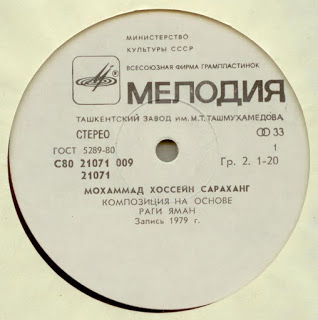
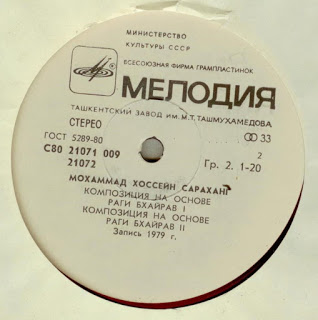


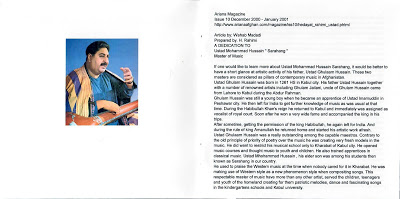
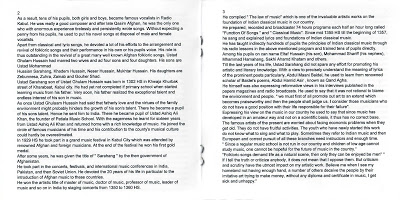
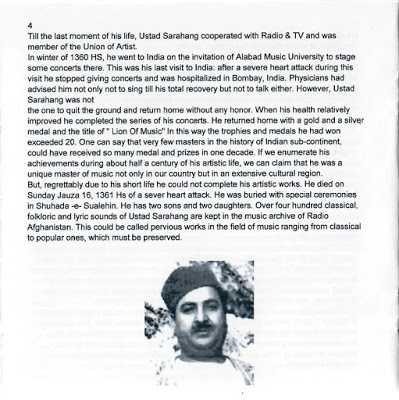

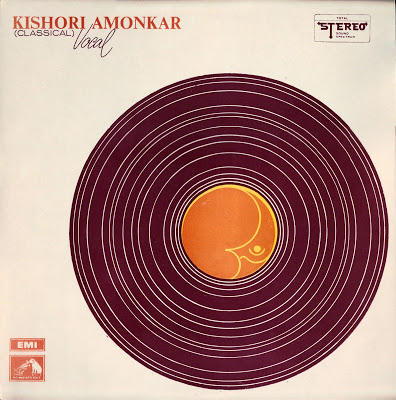
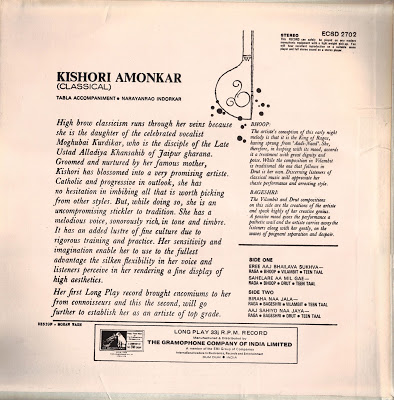
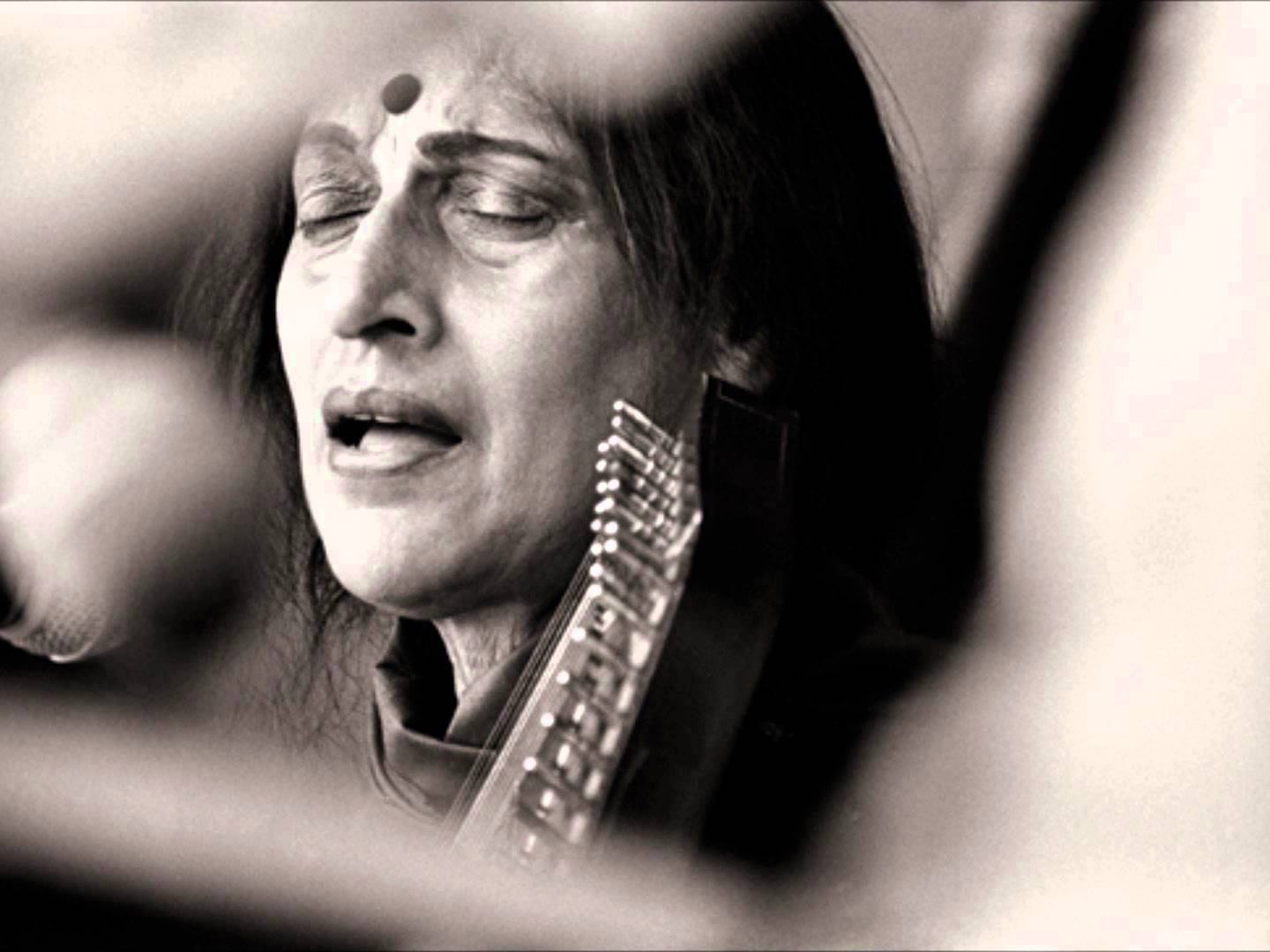
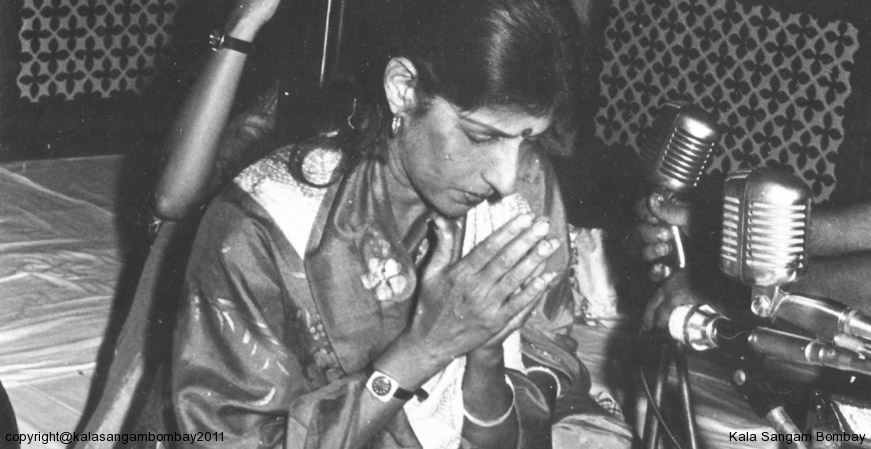
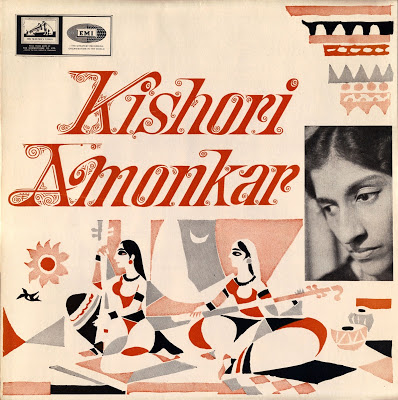
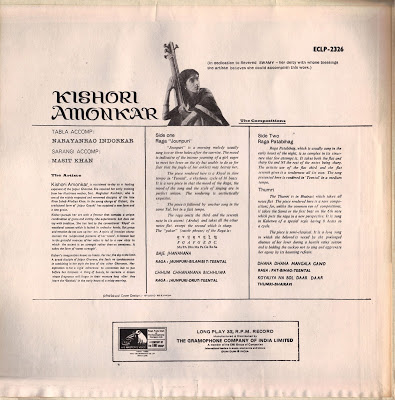
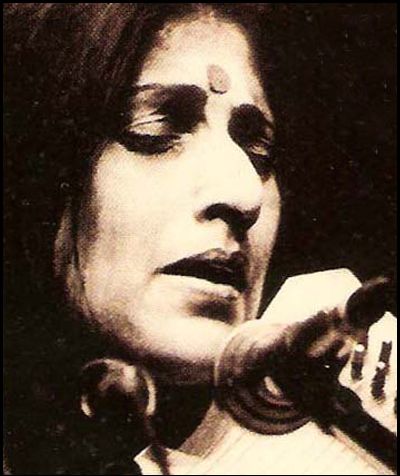


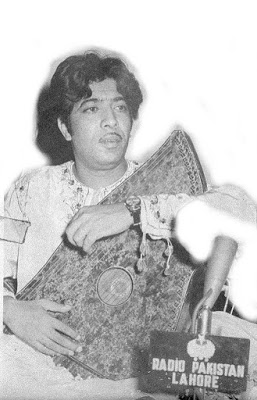
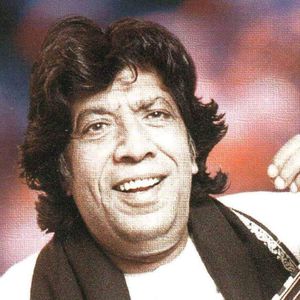


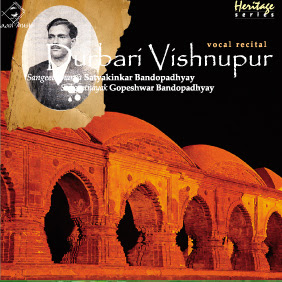
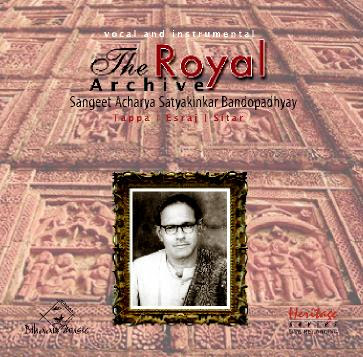
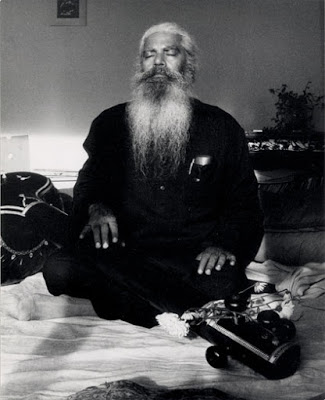


%20-%20front.jpg)
%20-%20back.jpg)